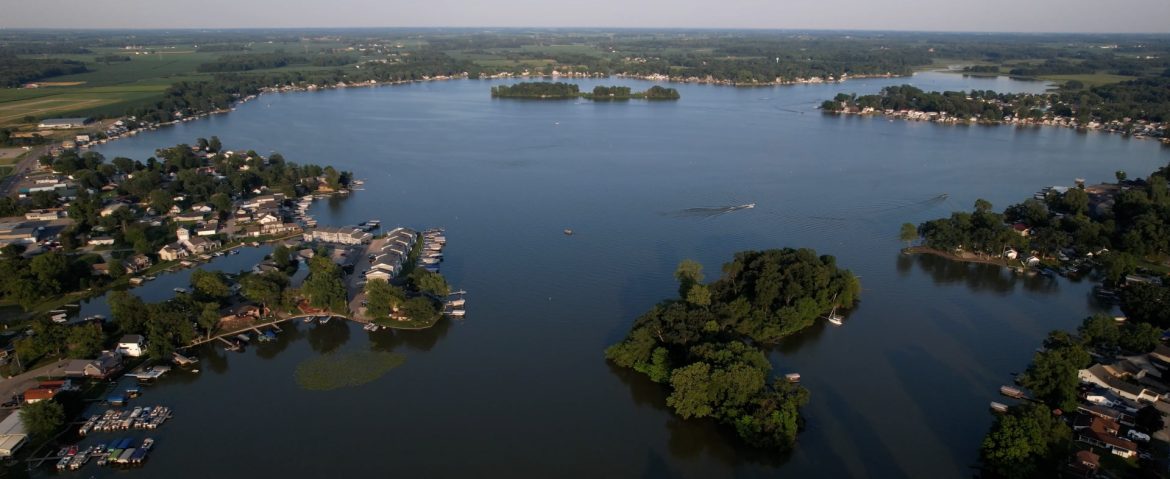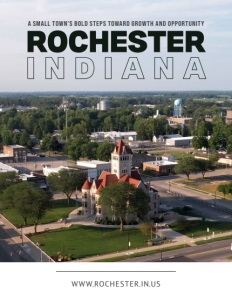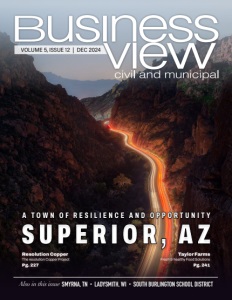Rochester, Indiana
A Small Town’s Bold Steps Toward Growth and Opportunity
Positioning itself as a welcoming community for new industries and hometown talent, leveraging a fresh vision and ambitious projects to make a difference.
Rochester, Indiana, is a quiet Midwestern town of just over 6,000 people, about 45 miles south of South Bend. Known for its small-town charm and proximity to Lake Manitou, Rochester embodies traditional values while balancing a desire for progress. The town offers a comfortable pace of life, anchored by local businesses, friendly faces, and a scenic lake that draws visitors each summer. However, Rochester has seen limited growth in recent years, and its leaders are now rethinking how to position the community for a brighter economic future.
Just ten months into his role, Mayor Trent Odell speaks plainly about the challenges he inherited. “Honestly, there hasn’t been much progress in terms of growth,” he admits. For years, Rochester operated with what the mayor describes as a “retirement community mentality” that didn’t prioritize expansion or new opportunities. He recalls a major business closing in 2016. “It was never really pursued to replace,” the mayor says. This stagnation, he suggests, was the reason I was elected. The people were ready for a change.
The mayor’s recent push for change has required tangible and symbolic actions. “We’ve got a groundbreaking tomorrow,” he says, “something we haven’t experienced in awhile”. In a town where economic development has been on the back burner for so long, even the act of breaking ground feels like a milestone. Mayor Odell’s administration is shifting the mindset of Rochester’s leaders and residents, encouraging them to look beyond the status quo.
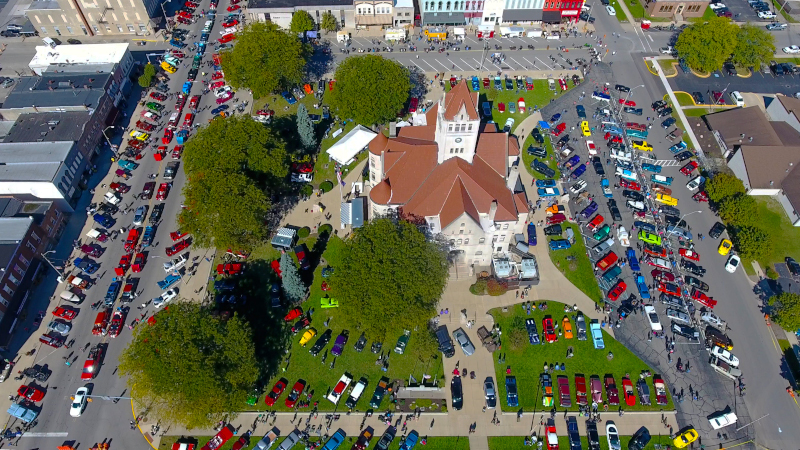
Turning the Tide
According to Michael Ladd, director at Fulton Economic Development, Rochester’s economic prospects are slowly beginning to shift. “If you grow up here, you live here long enough, you lose sight of what’s here,” he says. For him, the town’s unique assets—like Lake Manitou, a historic downtown, and a welcoming atmosphere—are often taken for granted by those who’ve known them their whole lives. Ladd believes Rochester needs a “new set of eyes” to recognize its potential and reimagine its role within the region, especially as nearby communities attract significant investment.
The groundwork for that transformation is underway, as local leaders consider an “all-of-the-above approach” to development. A community advocate and professional economic consultant, Charlie Sparks emphasizes that Rochester must prepare itself to compete for regional growth. “We’re seeing billions of dollars of new capital investment in every direction outside of Rochester,” he notes. To ensure Rochester is part of that wave, leaders focus on several key areas: housing, lodging, commercial development, and—perhaps most importantly—industrial development. A new industrial park is in the works, a project that could create jobs and stimulate the local economy.
Rochester’s amenities, though modest, offer a foundation to build upon. Mayor Odell points to Lake Manitou as one of the town’s strongest assets. “Right now, there’s not a great deal of tourism going on,” he admits, adding that while the lake and the events around it draw some local interest, there’s room for improvement. Traditional events, like chili cook-offs and classic car shows, are popular, but the mayor sees potential for more ambitious programming to attract visitors and boost local pride. He believes that with some effort, Rochester could create a more vibrant cultural scene that would give residents and tourists a reason to spend time downtown.
The people of Rochester, though, remain its greatest asset, according to Mayor Odell. “They’re very friendly,” he says, describing the town as a “comfortable community to visit.” In Charlie’s view, Rochester’s charm lies in its simplicity. “It’s clean, it’s safe, it’s charming, it’s comfortable,” he says, describing a place that residents love for its down-to-earth quality. As development efforts gain momentum, local leaders plan to maintain that character. For them, the goal isn’t to transform Rochester into something unrecognizable but to enhance what’s already here—making it a place where growth doesn’t come at the cost of the community’s soul.
Building Momentum: Industrial Growth and Infrastructure Investments
Rochester’s economic landscape is beginning to shift, fueled by a proactive approach to infrastructure and industry development. The industrial park project south of town at the U.S. 31 and State Road 25 intersection is at the heart of this transformation, signaling a strategic pivot toward accommodating larger employers and encouraging new sectors to set up in the area.
Mayor Odell explains that getting utilities to the industrial park site is a crucial priority. “Just the discussion about running utilities has already gotten the attention of our local and even state legislators,” he says. According to him, companies are starting to show interest in the location, with some even exploring the possibility of future partnerships. While specifics remain under wraps due to nondisclosure agreements, he hints that an agriculture-based company might break ground as early as next spring. “Honestly, we’re trying to get ourselves in a position to land some of these companies, but we don’t know what they’re going to be yet,” he says, acknowledging both the excitement and uncertainty that come with these early-stage negotiations.
Charlie sees Rochester’s central location as a strategic advantage, especially within Indiana’s broader industrial ecosystem. “We’re positioned between two huge new investments in battery technology and production,” he says, referencing a Stellantis-Samsung joint venture in Kokomo and a Samsung-GM battery plant in New Carlisle. Less than two hours from Rochester, both facilities are multi-billion-dollar projects tied to the automotive industry’s shift towards electric vehicles (EVs). He believes that Rochester’s new industrial park could capitalize on this trend. “We could see some activity in that sector, but we also want to work on attracting other types of investment,” he adds.
Ladd envisions the park as versatile enough to accommodate EV supply chain partners while providing opportunities for ag-related industries, aligning with Rochester’s agricultural roots. Mayor Odell, meanwhile, is focusing on building connections. “A lot of my efforts have been trying to open relationships with who is going to be our new governor,” he explains. These relationships could prove valuable as Rochester is a regional and state-level growth initiatives hub.
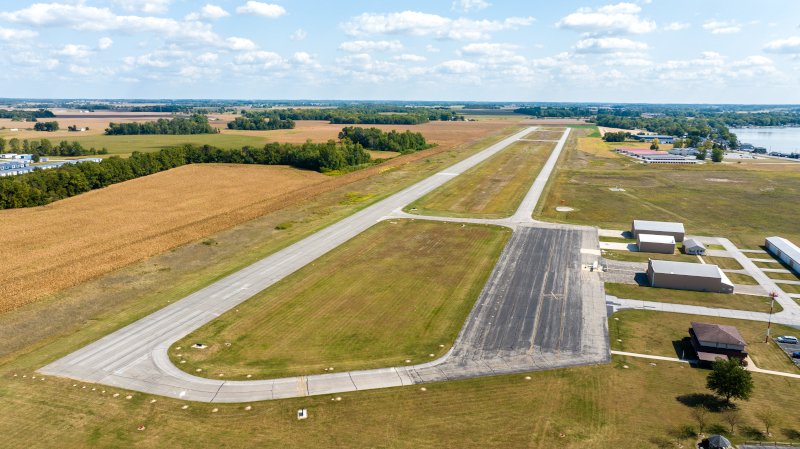
Building a Business-Friendly Foundation
Rochester’s leaders are focused on creating an environment that supports new and long-standing businesses while also addressing the structural needs that come with growth. Charlie indicates Rochester’s history as a hub for small and medium-sized manufacturers. “We have a number of manufacturers here that have operated successfully for decades,” he says. “These companies have provided steady employment and reinvested in their local facilities, contributing to the town’s economic resilience.”
As Rochester moves forward with its industrial park and other growth initiatives, Charlie assures that the contributions of these established companies won’t be taken for granted. “Even while we’re positioning ourselves to attract new employers, we still want to acknowledge and appreciate the economic impact of our existing employers,” he adds.
Housing is another critical piece of the puzzle. Ladd notes that Rochester’s housing stock needs to be increased to support the town’s growth ambitions, a challenge compounded by the need for modernized utilities. “One of the things I recognized when we came in was we didn’t have the basics in place,” he says. Ladd’s organization, Fulton Economic Development Corporation (FEDCO), has engaged four to five developers to explore new housing projects to create a pipeline of homes for the anticipated workforce.
Despite widespread support for growth, Mayor Odell admits that some residents express hesitation when developments encroach on their neighborhoods. “Everybody’s a hundred percent on board, of course, until it goes in the backyard,” he says wryly. However, with the industrial park planned on the far side of U.S. 31, away from residential zones, the city hopes to minimize community pushback. The mayor stresses that Rochester is committed to attracting clean, responsible industries, noting, “We don’t want dirty industrial air blowing across the city.” Each prospective company will be evaluated to ensure it aligns with the town’s vision and environmental standards.
The question of “what to build first”—housing or industrial facilities—has been a topic of debate among Rochester’s leaders. However, Ladd states that Rochester’s major projects are all interconnected. “For example, without adequate housing, new jobs created at the industrial park won’t attract local applicants,” he says. “Meanwhile, without job opportunities, there’s less incentive for developers to invest in housing.” Ladd cites one local employer where “literally 75% of his employees live outside of Fulton County and commute in every day,” highlighting the urgent need for more local housing.
Architecting a Future of Belonging and Opportunity
As Rochester plans its next chapter, local leaders are creating a community that attracts new residents and businesses while drawing back those who may have left. There’s a push to nurture a sense of place, a culture that appeals to newcomers and lifelong residents. Mayor Odell sees a key part of his mission as cultivating this culture of belonging and ambition. “We need to create that culture and a place where people want to come or want to come back,” he says.
Ladd is optimistic about the road ahead due to the transformation that’s already begun. “The future is whatever we’re going to make, and we have an opportunity that we didn’t have 10, 11 months ago,” he says. The shift in leadership, combined with a renewed focus on growth, has sparked a change in attitudes across Rochester. “It’s up to the community and their leadership to figure out, ‘What do you want to be when you grow up?’ and then go pursue that,” he adds, capturing the sense of reinvention taking hold.
For Mayor Odell, building this future goes beyond economic development; it embraces empowering the people of Rochester to channel their talents and ambitions. “One of the responsibilities I have as mayor is to create a conduit for our leadership talent plus our general community’s talent to be launched and used,” he says. He believes the town’s creativity and drive have been “squelched” for too long, stifled by a lack of opportunity. Now, he’s committed to providing an outlet for that energy, encouraging residents to “run with ideas” and make their mark on the new Rochester emerging from a sleepy past.
AT A GLANCE
Rochester
What: Small-town revitalization and economic development initiatives
Where: Rochester, Fulton County, Indiana
Website: https://www.rochester.in.us/
